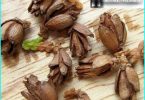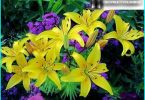The contents
Soil preparation: drainage and fertilizing
Irises are not very demanding, but there are several points that you should consider. They are not recommended:
- waterlogged soil;
- poor mineral soil;
- constant shadow.
Protection from excessive humidity is planting plants on artificial slope. If ground water come close to the roots, it should build a small elevation with a slope to the South side and a drainage system. To do this, simply raise the bed by 20 cm and to ensure the flow of rain water.
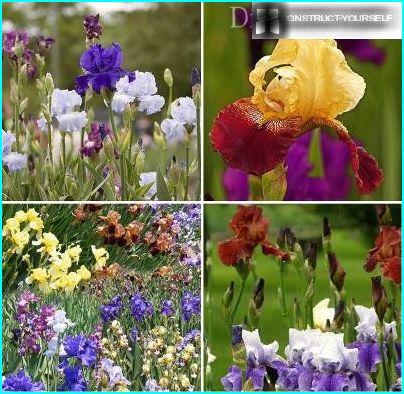
There are several ways of planting irises: single, cluster, group, free seeding. Flowers with large buds used for single landing, with small — group
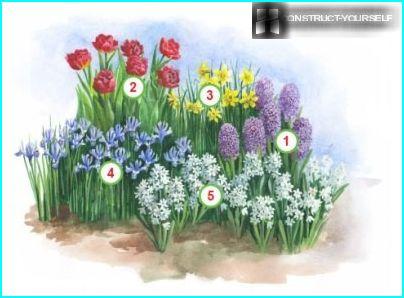
A sample of flowerbeds with irises: 1 — hyacinth purple voice; 2 — Tulip Flashpoint; 3 — Narcissus new Baby; 4 — iris mesh Cantab; 5 — Siberian Scilla Alba
Irises love sunlight, but some of the time can spend in the shade, so the flower garden it is desirable to break on unshaded or lightly shaded areas. Before planting, enrich the soil with organic fertilizers, then carefully dug and loosened. Manure is usually applied in advance, about a year before landing.
The ideal soil for bulbs – lime. Alkaline reaction provide is listed in the soil during digging lime, chalk or egg shells. Sandy soil it is best to dilute the humus, not the superfluous will ash and 40 g of superphosphate (per 1 m?). Clay, on the contrary, it is better to dilute sand coarse fraction and add to the enrichment of a bit of humus or compost.
Article topic: liming the soil in the garden: why, when and how it should be done?
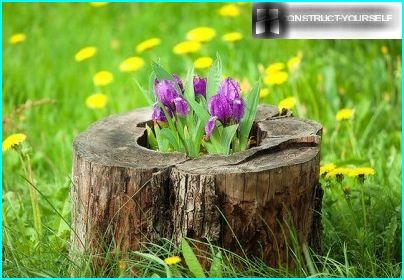
Do not be limited to traditional flower beds arranged in recreational areas and along paths. Original flowerbed-stump looks much more attractive!
Landing colors can not be changed for about 10 years, hybrid varieties – 5 years. The ability of iris to the rapid growth leads to nutrient deficiency in the soil, resulting in the change of place, that is, the transfer of beds.
Autumn is the time of planting bulbs
First things first invite you to watch a video on the topic:
Features of the planting depend on the variety. In a temperate climate well survive and tolerate the winter iridodictyum, Turkey and the Caucasus, as well as their hybrids. Choose dry, open ground and dig shallow pits, up to 7 cm place the bulbs so that the soil clung to him tightly, and better in its composition will add a bit of sand. To protect plants from fungal diseases, bought the bulbs pre-processed «Fundazol» or «Bolatom». In the summer, after the death of the stem and leaves, separate small daughter bulbs, which are essential for further reproduction.
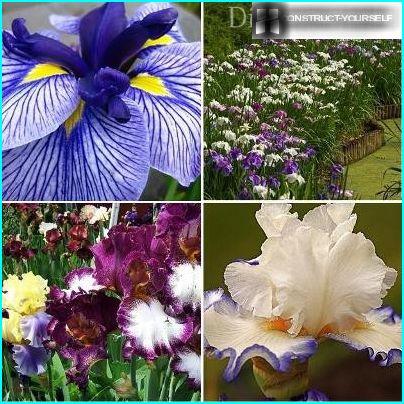
For decorating flower beds, apply one or more varieties of irises. Variety of colors allows you to create the rare beauty of the composition
Onion varieties «Juno» are large in size and the presence of fleshy roots updated annually, contact with whom should be very careful. If the roots will disappear, the plant will die. The best time for planting iris bulbs in the open ground the last week of September or first week of October. The bulbs are gently lowered into the pit, so as not to damage the roots, and sprinkle a layer of soil with thickness of 6 cm.
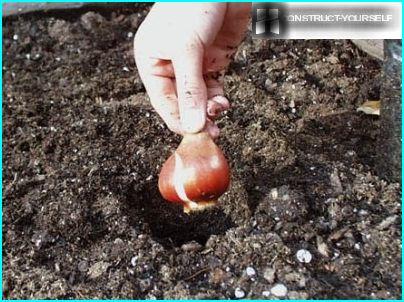
The hole for planting should be relatively small — approximately two heights of the bulb, therefore, for a small cupolas of irises suitable depth of 4 to 7 cm
Summer training is that the bulbs are dug after the withering of toffee and dried at the ambient temperature of 22-25?C. the Second option is a bed cover with foil, protecting it from the rain, until the beginning of October. Further reproduction of Juno subsidiaries produce or bulbs, or seeds that are sown in special boxes. The boxes with seeds and bulbs should be dried. Seedlings appear usually in the second year.
The distance between plants when planting can be different: consider the minimum gap in two widths bulbs(the result is a thick Bush), maximum – up to half a meter (usually single planted irises with a fluffy buds).
Use a plastic basket for rearing
In the supermarket you can buy simple but very convenient cart for the cultivation of bulbous crops.
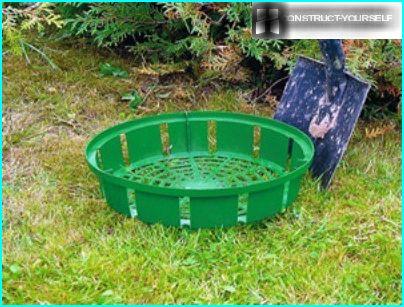
In order to remove a piece of turf, put the plastic basket on the desired area and circumference by means of a shovel or scoop, outline the contour to a depth of 12 cm
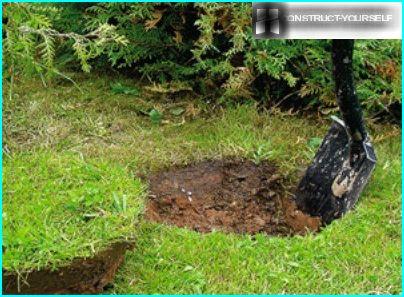
Carefully remove the separated piece of turf, and the resulting hole deepened by about 20-30 cm, to a fully-fit basket
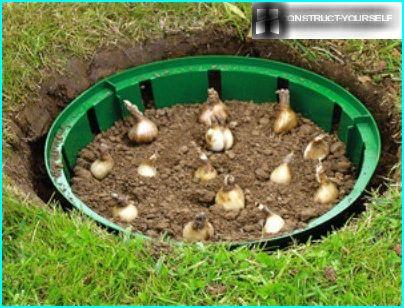
On the bottom of the pit pour the fertilizer, then set the basket. Fill her tight moist layer of fertile soil and planted the bulbs
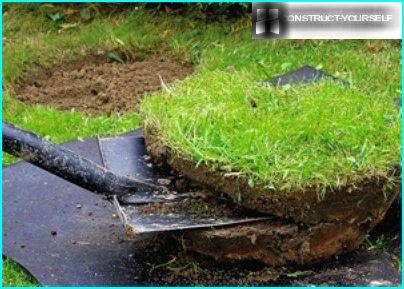
Sleep planted the bulbs a thin layer of earth and return back the seized piece of turf. Thus, the bulbs all winter will spend in favorable conditions for themselves
Basket convenient because it is easy to reach from the ground and along with the planted follicles move to a drying room for.
How to care for irises?
In addition to timely planting and prepare the soil, care for plants during their flowering time: early irises begin to bloom in may, late in June. The proper care of bulbous iris is regular fertilization and protection from pests. Another point of caring about flowers – watering. During the rainy season to water irises should not be, and in dry seasons it is necessary to moderate irrigation is strictly in the evening.
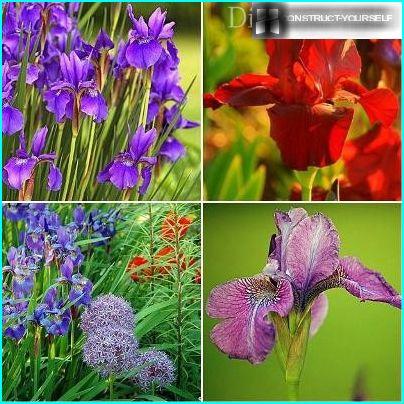
It is important to choose varieties of flowers. For example, the Siberian irises are considered the most frost resistant, so they can easily withstand the winter in Northern latitudes
Mineral fertilizers
In the spring, after the snow melts, waiting for the full drying of the top soil in order to fertilize it. Will fit ready-made solutions and universal dry mixes, for example, «Reaser» or «Good force». Put the required amount of feeding in the top layer (or just sprinkling on the surface of the soil around the bulbs), then razryhlitel carefully, trying not to catch the roots.
One of the three-stage variants of fertilizing hybrid irises is not the first year of flowering:
- nitrogen, potassium, phosphorus (2:3:1) and spring in a dry soil;
- the same composition, but in a different proportion (3:3:1) at the time of Bud formation;
- potassium, phosphorus (1:1) to 1 month after the beginning of the flowering period.
Regular and correctly dosed fertilization ensures a high decorative quality, rapid development and long flowering. One of the most important periods in the life of the plant – formation of flower buds. Fertilizing at this stage provides a lush, full flowering next year.
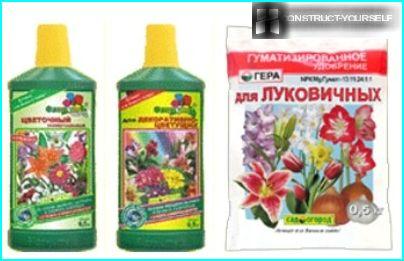
Fertilizer for bulbous contain Lignohumate, which performs several important functions: it promotes rapid growth, increases resistance of plants to diseases, increases the decorative effect
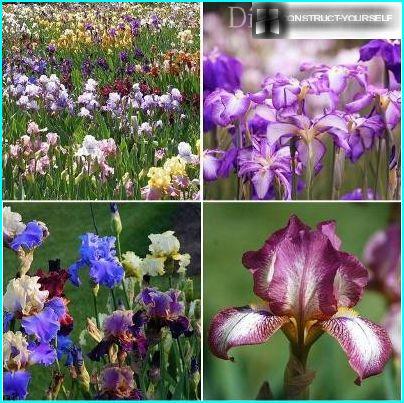
Don’t have to do alone complex fertilizer for flowers, the shop sells ready-made compositions for bulbous in two types: solution and dry mix
Closely monitor the amount of nitrogen. The excess of this substance cause «greasing» — the process is wonderful when leaves develop, but not fully flowering.
Preventive protection from pests
Despite the short period of flowering, cultivation of bulbous irises is accompanied by protective measures. To prevent unwanted parasites should be a routine sprayings every two weeks. To start with the period when the leaves reach a length of 10 cm are Usually used «Malathion» (helps against phytophagous mites) or a General toxic chemicals. With the beginning of the buds of treatment stop.
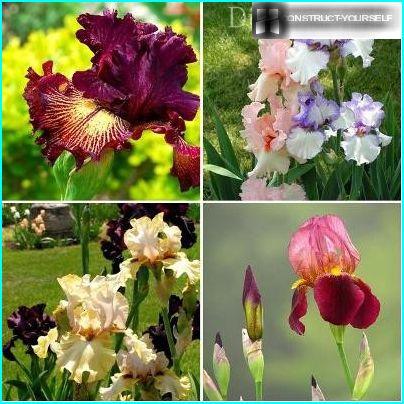
Irises have often found disease of the roots and bulbs — bacteriosis, which causes the decay of the individual parts. Dig the plant, remove diseased parts are washed in potassium permanganate and transplanted to another location
How to determine disease in bearded irises? Usually a healthy plant has a tuft of 7-9 leaves, whereas the patient can detect not more than 5. A problem occurs with the formation of flower buds. For the treatment plant is dug up, cleaned of rot and insects, treated with antiseptic. If irises are affected with thrips, the natural waxy coating on the leaves is broken.
Prevention is to prepare the bulbs for next year – remove the old stem with the leaves, stems and flowers, which can remain harmful insects.
Traditional treatment for irises guarantees their extraordinarily vivid bloom and the possibility of creating unique flower gardens.


